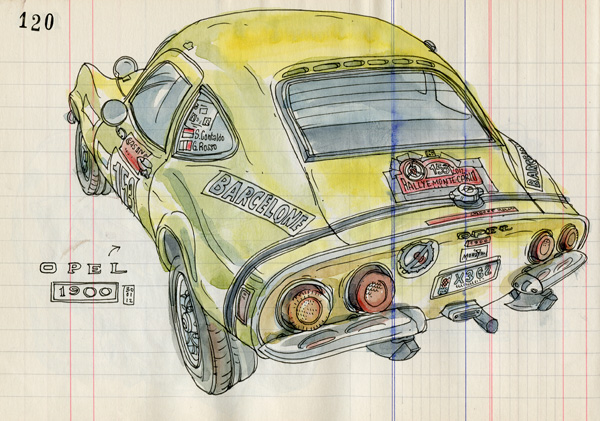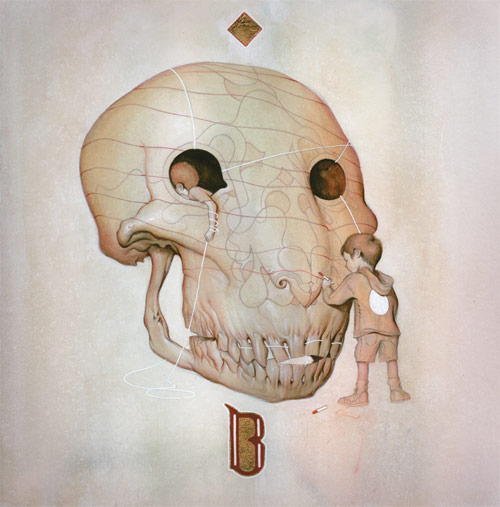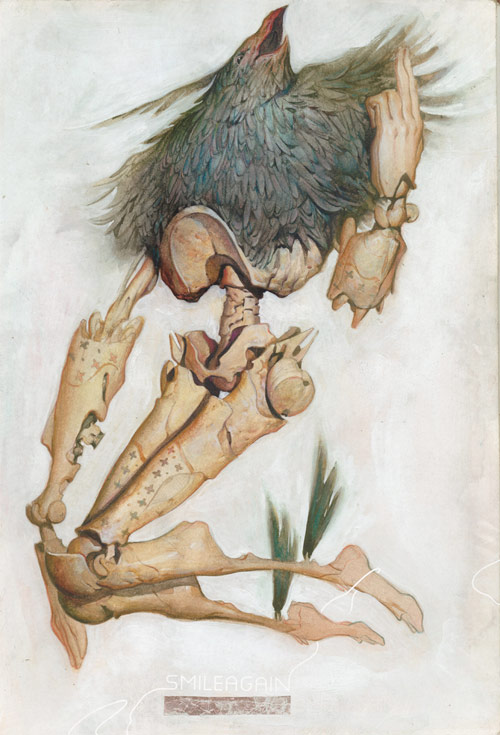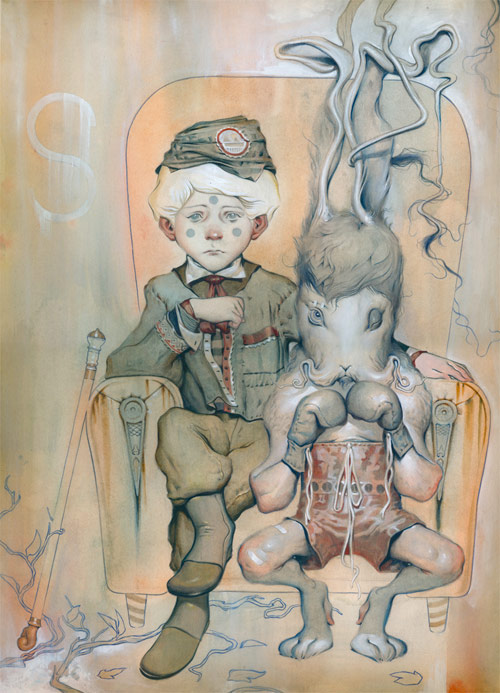
Tuesday, January 31, 2012
Epic Sketchbook: Car Sketches by Lapin and Sagar..

Friday, January 27, 2012
Thursday, January 26, 2012
Kung Fu Panda 2

OK. I knew this review is a little bit late – but I’ve been traveling a lot this year and I finally found time to watch the animated features I missed.
Even though I heard good things about Kung Fu 2 – and I really liked the first film – I’ve finally watched KFPII. And I must say I really liked it.
The art was even better than the first and the humor and character development were terrific.
The only drawback for me was the action came on too fast and intense.
In fact it was brain overload and my mind shut down and I fell asleep through sections. (The same thing happened during “9” and “Arthur Christmas”) Now, you might say that my fuddy duddy brain is too slow for the new action films. That’s a fair criticism.
But nevertheless I have to grade the film to my own standards: and even though I liked KFPII, I can’t give it my highest score. So I’ll give the Dreamworks feature a B.Epic Sketchbook: Audrey Kawasaki...
Wednesday, January 25, 2012
Animation 101: 11 Tips from Jeremy Cantor, Animation Supervisor Sony Imageworks...
1. Establish and maintain good contacts.
The old adage, "It's not what you know, it's who you know", certainly applies (to a certain extent) in this industry. I landed my first "real" job on my own, but every one I’ve scored since was the result of a contact (including freelance side-jobs). Keep in mind though, that contacts only help you get in the door. Your skills and professionalism are what will keep you employed. Where do you meet future contacts? At school…on the job…at professional lectures and gatherings…online mailing lists and forums (www.cg-char.com for example) It is also extremely important to keep in mind that if you "burn bridges" and make enemies, the notion of “who you know” can actually be a significant disadvantage to your career growth. Just as a positive referral can help you "get in the door", a negative referral can ensure that certain doors will always remained closed to you. Remember that everyone knows everyone in this field. Try putting someone else’s work on your demo reel and see how long it takes to get blacklisted from an entire industry. (Actually, don’t try that. Just trust me).
2. Don’t go after jobs/compaines where you’re not interested in the subject matter of their end product
Once you gain a foothold in the industry, choose your career path wisely. If you think video games are stupid, why would you want to work for a video game company? You won't have much to talk about with your co-workers and you certainly won't "climb the ladder" because doing so often requires working above & beyond the call of duty (long hours in stressful environments), learning new software or techniques on your own time, and taking the initiative to "push the envelope" creatively or technically. Someone who lacks a passion for the end product will be very unlikely to do such things. These jobs demand a lot from you: Time, creative spirit, and the ability to handle a lot of stress. Anyone taking on such a job "just for the money" will certainly not last very long. When you’re just starting out, however, try not to be too picky or think that any job is “beneath you”. If the industry is somewhat slow (like today), grab whatever you can to gain experience. Do a cheap, local cable TV commercial for the stereo store down the street. Design a tee shirt for your neighbor’s son’s Bar Mitzvah. Take an internship.
3. Have the ability to receive and professionally respond to criticism and failure.
The ability to accept defeat on occasion is perhaps the single most important quality that separates successful talented people from non-successful talented people. How many times have you heard the story of the author whose million-selling novel had been previously turned down by dozens of publishers? (Can you say: “J.K. Rowling”?) Accept the fact that you won't get every job you apply for. Your short film won't get accepted into every festival. Your director might not like your animation, and he might be in a bad mood that day and will therefore deliver his critique without much concern for diplomacy. Be prepared for the possibility that you might spend a month on a shot only to have the editor cut it from the film at the last minute. Remind yourself that a criticism of your work is not necessarily a criticism of you as a person. In "creative" fields, a lot of the work is highly subjective. Not everyone is going to like everything you do. Bill Cosby once said that while he doesn’t know the secret to success, he knows that the secret to failure is trying to please everyone. You can certainly strive to please everyone, just don’t expect to. If you can at least please yourself most of the time though, you’re pretty much ahead of the curve.
4. Take (and create) opportunities to learn and grow on your own time.
You need to keep up with the creative and technical standards and advances in these industries in order to stay employed. There are always going to be fresh, new, talented college students out there willing to do your job for less money. You always need to stay a few steps ahead or you'll get left behind. Don't look at your fellow students' work as your competition. Look at the best work in the world and strive to be better than that.
5. Develop the ability to FINISH.
The ability to take something through to its conclusion is another significant ingredient for success. How many people do you know who have a dozen unfinished project ideas sitting on their desks? Very few people finish absolutely everything they start and achieve every single one of their goals, but if you've ever felt the satisfaction of completing at least one task, it'll be that much easier for you to do so in the workplace. It’s a learned skill. Why is finishing so hard? It often comes down to one word: “Stamina”. The start of a project is usually fresh and exciting. It's easy to stay motivated in the beginning. The latter stages, however, can often become tedious and frustrating and require a lot of hard work to muscle through to the end (like the last mile of a marathon race). If you can only stay motivated and focused during the fun parts and you lose interest when the fun level diminishes, you won't finish too many projects.
6. Go where the action is.
If you want to be an animator in the Visual Effects industry and you live in Louisiana, it's rather unlikely that your dream is ever going to come true unless you're willing to relocate to California (or New York, or Vancouver, etc). You'll never become a professional surfer if you refuse to leave your home in Northern Alaska. If, however, you already live in a hotbed of animation activity, such as Los Angeles, take advantage of your locale. Join professional organizations like ASIFA & Siggraph and attend their meetings and lectures. Go to pre-screenings and film festivals. Visit museums and galleries. Take classes at the Cartoonist's Union. Seek tours and internships at local studios.
7. Always be “Scottie" (ABS).
…as in Engineer Scott from Star Trek. When asked to solve a problem, he'd very often respond by saying "I don't know if I can do it, Captain! The forward thrusters are shot and we're all out of Dilithium Crystals". In other words, it's often advantageous to overestimate (within reason) how long it will take to complete a requested task, and then negotiate down (and you can always expect to negotiate down). That way, you'll be much more likely to come in ahead of schedule and look like the hero (or at least a competent professional). Resist the temptation to impress your bosses and demonstrate a positive attitude by always saying "No problem, I can knock that out in an hour!" More often than not, because of forces beyond your control (technical snafus, supervisor inaccessibility, inconsistent direction), tasks in this industry tend to take longer than you might initially think. You don't want to be constantly making excuses because you were too enthusiastic and optimistic with your initial time estimates. Be reasonable with the ABS technique however. If you wince and grimace every time you're asked to do something and your time-to-completion estimates are always obviously over-inflated, you could end up being labeled as "the boy who cried wolf" or worse yet, be accused of having a "negative attitude".
8. Take responsibility for your actions
In general, supervisors hate it when artists constantly blame others for their problems. If something weird pops up in your shot during dailies, and you know it was the result of a mistake or an oversight on your part, cop to it. In fact, it's usually best to nip-things-in-the bud by pointing out the mistake before anyone else does. Sometimes, of course, things do go wrong and you are truly not the one to blame. But it's generally a good idea to look to your self first before pointing the finger at others. Place the blame elsewhere only after you've ruled yourself out as the culprit. Admitting to a mistake empowers you to fix it. And, furthermore, doing so validates your successes. (How can you take the credit for your positive achievements, if you won't take responsibility for the things that go wrong?) This, of course, does not imply that it's okay to screw up all the time just as long as you take the blame and apologize.
9. Don’t expect the quality of your work to make you immune to the consequences of unprofessional behavior.
Some folks want to believe that if their work is strong, nothing else matters. Professionalism is just as important to career success. In rare cases, someone who does not play well with others will somehow manage to stay employed for a while if their skillset is deemed irreplaceable. However, a bad reputation always catches up to them eventually. Dennis Rodman could get away with dressing like a woman, hurling obscenities at referees and kicking cameramen as long as he was the number one rebounder in the NBA. However, such imbalances of talent vs behavior never seem to last. Stats will eventually slip or others will come along with stronger stats and better attitudes. I’ve seen a number of talented individuals fall from grace after becoming corrupted with power. Always work to continually improve your skills, but don’t forget to continually improve your professionalism as well.
10. Backup!
No matter how careful you are, it is inevitable that you will someday accidentally overwrite an important file or sit down at your PC only to find that your hard drive has crashed. Backup your files regularly and save copies in alternate locations.
11. Keep things in perspective.
Working in this industry is often not nearly as glamorous as it may sound to folks on the outside. Hours can be very long. Stress levels can get very high. Supervisors can be really nasty at times (and occasionally you might find yourself asking, “Why am I working for this clown? I know more about animation than he does!”) Step back once in a while and remind yourself why you got into this field in the first place. Someone (hopefully) is actually paying you to do your hobby! When things get really stressful, take a breath and remind your self that it’s just a movie (or a game or a commercial, etc). Do the best job you can, but don’t let yourself get sucked into the stress so deeply that you miss out on having “a life”. If you’re on a high profile film production, accept the fact that it’s not your film. On such projects, you will have limited (if any) creative control over your animations. Start a shot with enough artistic passion to do a great job, but not so much that you’ll be unable to sleep at night when the director completely changes his mind and makes you start over at the last minute, or worse yet, cuts your shot from the movie after you worked on it 14 hours a day for 20 straight days. It takes a while to find that balance within yourself, and every project will require you to do things just a little bit differently. Make necessary sacrifices and put in the extra hours as needed to “climb the ladder”, however, be careful that you don’t find yourself looking back after 10 years to find that, while you have a few decent films under your belt, you have no friends, you have more gray hairs than your grandfather and you missed all of your kids’ little league games and school plays. Make sure you’re enjoying your work most of the time and you have an appropriately balanced life.
Tuesday, January 24, 2012
Monday, January 23, 2012
Friday, January 20, 2012
Vernon Courtland Johnson..





Thursday, January 19, 2012
Kodak Focus on Animation
This screening has been such a popular event that it sells out immediately! Our good friends Anne Hubbell, Susan and Dewitt are always so hospitable and welcoming to our January cartoon show. They put out a great spread, then we moved to the fancy screening room where it was standing room only.
There were the usual celebrated films “Luminaris”, “Paths of Hate” and “The Fantastic Flying Books of Mr. Morris Lessmore”. But we put in some surprises: a clip from Signe’s new feature film “Rocks in my Pocket” that looks and sounds fantastic! David Levy’s new short and a delightful film I discovered at the Burbank Festival called “Notes on Biology” by Danny Madden.
After the screening we all trekked down to Billy Mark’s Bar and got drunk and talked about our favorite film and ripped apart our least favorites.
I love introducing new artists and films to audiences and I believe that’s why I enjoy so much doing the Kodak Show.
Thanks to everyone at Kodak!Illustrations by Gerhard Human..
Cape Town artist/Illustrator Gerhard Human has got some interesting stuff, visit his blog for more. Enjoy!
Wednesday, January 18, 2012
Tuesday, January 17, 2012
Skull Nickels.. awesome..
These are called Hobo Nickels crazy. Most are the work of unemployed artists during the depression (thus, “hobo”). A number of artists etched away the flesh of the subject to reveal these awesomely macabre skulls. Hobo nickel carving remains a popular hobby today and it even has a society. Images linked to their sources, most of which are live ebay auctions. Enjoy..
















































